WHAT'S NEW:
Eruption Confirmed!
New lava (rumbleometer stuck in flow) SE rift zone
(posted 9/1/98)
BACKGROUND:
Technology (ROV, ships, etc.)
Other 1998 Axial cruise reports
EXPEDITION:
Science Objectives
Calendar
Today's Science News
Participant Perspective
Teacher Logbook
EDUCATION:
Curriculum
Teacher Observations
Questions/Answers from sea
MULTIMEDIA:
(video clips, animations, sounds)
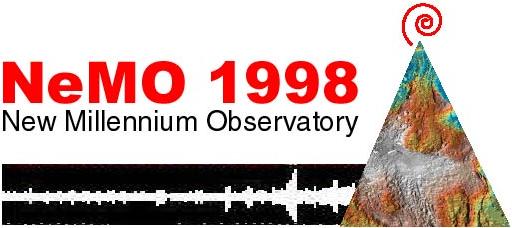
Logbook
September 2, 1998
September 2, 1998
Contents:
Science Report
Daily Science Update - early September 2
current location = 45 56.4'N/129 58.9'W
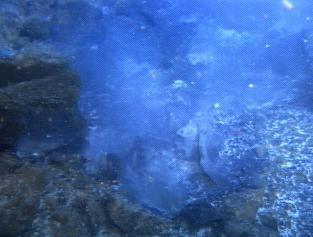
|
Photo taken within the new lava flow showing hydrothermal fluid seeping from cracks within the lava. This type of vent is called a "diffuse" vent. Bacteria and particulates emitted from the fluid coats the lava as fine sediment. (photo: ROPOS NeMO 1998) |
Each ROPOS dive gets a number and our first dive at Axial was dive 460. Our fourth dive (463) was ended early after 16 hours on the bottom because the vehicle developed tether problems. The problem was quickly corrected and ROPOS is now on the bottom again (continuing where we left off) conducting dive 464.
The long duration of the dives is a logistical challenge to the science party. On the
one hand
when ROPOS is down on the bottom and working, no one wants to bring it back up.
There are many objectives we are trying to do on each dive and it is always
tempting
to add more once we are down there because we are always bumping into
fascinating
new sites. But on the other hand, no one person can stay up for that many hours
(even though many of us try!). There are data and samples to process from the
previous dives, plus planning for future dives, in addition to directing and
efficiently
collecting information during the current dive. It is a real challenge. At any
one time
there are about 8-12 people in the ROV control room (3 ROPOS pilots, 1
navigator,
1 video watchstander, 1 datalogging watch stander, 1 watch leader, and then
other
investigators who are directly involved in what ROPOS is going at the time).
Sleep
patterns for most of us have become very irregular, because ROPOS is determining
when we have to be up and we just catch sleep in between those times.
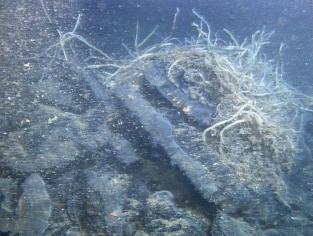
Every day we have a meeting to share results, and coordinate our plans for the next dive day. Today's dive will include tube worm, bacterial, and sulfide sampling. Recent highlights include finding a patch of tube worms that barely survived the eruption because they are located right on the edge of the new lava flow (photo above). A lobe of new lava came right up against the worm patch and they were happily bathing in the warm water coming up around the lava lobe. This seems amazing that anything could survive being almost overrun with lava, but on the edge of the flow it is very thin (10-20 cm) and once the lava quickly cools in the 2 degree C water the lava crust becomes a very good insulator, keeping most of the 1100 degree C heat away from its surroundings. We have found no new colonies of tube worms on the new lava itself.
Listing of all Science News postings
Life at Sea: Participant Perspective
Kevin Roe
NOAA Vents Program, Seattle
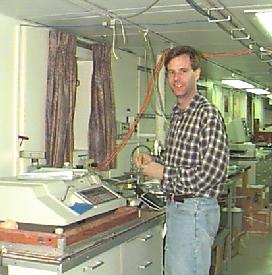
Hi! My name is Kevin Roe and I'm with NOAA/PMEL and the University of Washington. I'm working with Dr. David Butterfield, researching the chemistry of hydrothermal vent fluids.
What is a hydrothermal vent fluid? When seawater percolates through the ocean crust and encounters a heat source, such as at an ocean ridge spreading center or undersea volcano, seawater is heated and reacts with the rock. Magnesium and sulfate are removed from the fluid, and it becomes more acidic. Metals and silica are extracted from the rock and hydrogen sulfide, that rotten-egg gas is produced. If phase separation has occurred (most people call this boiling) hydrothermal fluid can be less or more salty that seawater. Hydrothermal fluid escapes the seafloor as high temperature vents, such as black smokers at up to 400 degrees C and as warm diffuse venting . We sample hydrothermal fluids with unmanned robot submarines such as ROPOS and manned submarines such as ALVIN.
My job onboard this ship is to analyze vent fluids for hydrogen sulfide, ammonia, pH, alkalinity and dissolved oxygen. All of these analyses must be done quickly as these chemical species are quickly oxidized, bubble out of solution or utilized by bacterial growth in a short period of time. I do take sub-samples back to the laboratory to analyze for the more stable chemicals such as sea salts and metals.
Dave and I sampled some of these same sites with the Deep Sea Vehicle ALVIN July 7-July 26 of this year and we are getting a more extensive "tour" of the eruption site at Axial seamount. An advantage of using an unmanned robot sub is that it can stay down longer (greater than 48 hours) and everyone who's awake can watch the progress on video monitors. It is almost like being there.
Kevin Roe
Listing of all Perspectives postings
Teacher At Sea Logbook
September 2, 1998
September 2 - 0753 hours
Bells ringing. . ."Fire. This is not a drill. Repeat, this is not a drill. Report to your assigned station." You learn just how fast you can get out of the upper bunk. Less than one minute later, "Belay, belay. Smoke from the incinerator room. Stand down." An interesting way to start the day. You might think that with all this water around us, fire on board would be no big deal, but the idea here is to keep the water outside the ship. I remember my science teacher droning away about buoyancy or density or something like that.
We are hoping to bring you a very interesting photograph by this weekend. We are scheduled to receive a much needed computer board for one of our water samplers. A problem early in the voyage fried the existing board and we have no replacement on board. How do you deliver such an item to a ship 300 miles at sea? You might expect a fishing vessel or a helicopter to make the delivery. Even a submarine might do in a pinch, but we are going to get airmail special delivery. A C-141 Starlifter (courtesy of the U.S. Air Force, McChord Air Force Base, Washington), one of the largest cargo planes in the world will over-fly our position and toss the part out of the cargo hold into the sea. We will recover the floating package with one of our small boats. We clearly could not hire a plane of this size to deliver a small package, but the C-141 has another mission that will bring it very close to our position and they will make the delivery. I expect to see lots of cameras pointed skyward for this unusual event.
1900 hours-
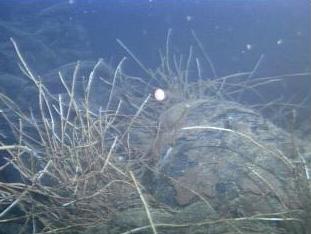 This was a very eventful day. The ROPOS was on the bottom collecting samples until the
seven function arm stopped functioning at all. Fortunately we had finished all of the
planned sampling and were able to bring all of those samples aboard. We have tubeworms
and bacteria traps and parts of one of the chimney structures made of a substance called
anhydite (photo of anhydrite chimney structure ROPOS 1998). We also have water samples taken directly from the hot water streams emitted
from the hot vents. You can smell the sulfur (sulfide) in the water as the samples are
removed from ROPOS. The technicians are already at work repairing the arm and
attaching the next set of scientific tools so that ROPOS can be back in the water in a
matter of hours. Meantime the scientists are in their lab areas collecting data as quickly as
possible.
This was a very eventful day. The ROPOS was on the bottom collecting samples until the
seven function arm stopped functioning at all. Fortunately we had finished all of the
planned sampling and were able to bring all of those samples aboard. We have tubeworms
and bacteria traps and parts of one of the chimney structures made of a substance called
anhydite (photo of anhydrite chimney structure ROPOS 1998). We also have water samples taken directly from the hot water streams emitted
from the hot vents. You can smell the sulfur (sulfide) in the water as the samples are
removed from ROPOS. The technicians are already at work repairing the arm and
attaching the next set of scientific tools so that ROPOS can be back in the water in a
matter of hours. Meantime the scientists are in their lab areas collecting data as quickly as
possible.
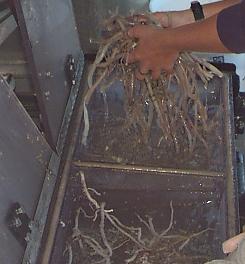 The worms are in the cold storage locker where they will remain alive long
enough to produce some important information. Everyone is tired at the end of a day like
this, but it's a good kind of tired.
The worms are in the cold storage locker where they will remain alive long
enough to produce some important information. Everyone is tired at the end of a day like
this, but it's a good kind of tired.
We have been working relatively unexplored portions of the southeast side of the caldera. Soon we will be moving to a much more active vent area known as Ashes. There I hope to get my very first look at a black smoker. Stay tuned.
Logbook of all Teacher At Sea postings
Question/Answer of the Day
Send Your Question to NeMO
Back to Calendar